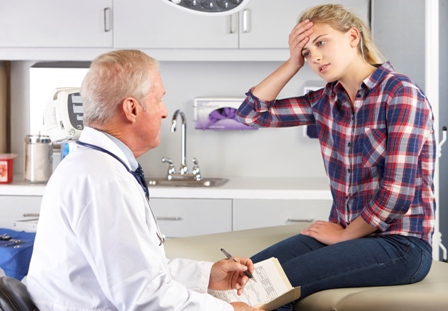User login
Two commonly used drugs to prevent migraine in adults, amitriptyline and topiramate, proved no better than placebo at preventing migraine in children and adolescents and also were associated with more adverse events in the double-blind, randomized Childhood and Adolescent Migraine Prevention (CHAMP) trial.
The findings of the trial, which was stopped early for futility following a recommendation from a data and safety monitoring board, suggest the adult model of migraine treatment in which both drugs have been effective may not apply to pediatric patients, according to the investigators (N Engl J Med 2016 Oct 27. doi: 10.1056/NEJMoa1610384). The study was published simultaneously with its presentation at the annual meeting of the Child Neurology Society in Vancouver.
The 24-week, multicenter trial involved 328 children and adolescents aged 8-17 years who were diagnosed with migraine with or without aura or chronic migraine without continuous headache. They were randomized on a 2:2:1 ratio to receive oral amitriptyline (n = 132), topiramate (n = 130), or placebo (n = 66) according to age (8-12 years vs. 13-17 years). The target dose in the study was 1 mg/kg of body weight per day for amitriptyline and 2 mg/kg for topiramate. Doses were escalated every 2 weeks over an 8-week period and dose modifications were made according to side effects.
Overall, 52% on amitriptyline, 55% on topiramate, and 61% on placebo reached the study’s primary endpoint of a relative reduction of 50% or more in the number of headache days from baseline to the last 28 days of the trial; the outcomes were not significantly different from one another. The participants recorded the number of headache days they experienced in a diary kept during and after the 28-day baseline period of the study.
No significant differences were seen between the groups in the secondary outcomes of headache-related disability, headache days, or the number of patients who completed the trial.
However, the authors observed higher rates of adverse events overall in the active treatment groups, compared with placebo. Amitriptyline users significantly more often reported fatigue (30% vs. 14%, P = .01) and dry mouth (25% vs. 12%, P = .03), whereas topiramate users significantly more often reported paresthesia (31% vs. 8%, P less than .001) and weight loss (8% vs. 0%, P = .02).
Other adverse events among topiramate users were fatigue (25%), dry mouth (18%), memory impairment (17%), aphasia (16%), cognitive disorder (16%), and upper respiratory tract infection (12%).
Serious adverse events included altered mood in three patients in the amitriptyline group and one suicide attempt in the topiramate group.
“Given the null outcome in this trial and the adverse events and serious adverse events reported in the amitriptyline and topiramate groups, the data do not show a favorable risk-benefit profile for the use of these therapies in pediatric migraine prevention, at least over the 24-week duration of the trial,” the study authors concluded.
They noted that during their trial, the Food and Drug Administration approved topiramate for the treatment of episodic migraine in adolescents aged 12-17 years.
“Although our trial included patients outside this age range and included those with either episodic or chronic migraine, the trial results suggest that prevention medication for pediatric migraine might be reexamined,” they wrote.
The high placebo response seen in the study suggested the placebo effect might be advantageous for children and adolescents with migraine, they added.
The trial was supported by grants from the National Institute of Neurological Disorders and Stroke and the Eunice Kennedy Shriver National Institute of Child Health and Human Development. The authors had no relevant financial disclosures.
Two commonly used drugs to prevent migraine in adults, amitriptyline and topiramate, proved no better than placebo at preventing migraine in children and adolescents and also were associated with more adverse events in the double-blind, randomized Childhood and Adolescent Migraine Prevention (CHAMP) trial.
The findings of the trial, which was stopped early for futility following a recommendation from a data and safety monitoring board, suggest the adult model of migraine treatment in which both drugs have been effective may not apply to pediatric patients, according to the investigators (N Engl J Med 2016 Oct 27. doi: 10.1056/NEJMoa1610384). The study was published simultaneously with its presentation at the annual meeting of the Child Neurology Society in Vancouver.
The 24-week, multicenter trial involved 328 children and adolescents aged 8-17 years who were diagnosed with migraine with or without aura or chronic migraine without continuous headache. They were randomized on a 2:2:1 ratio to receive oral amitriptyline (n = 132), topiramate (n = 130), or placebo (n = 66) according to age (8-12 years vs. 13-17 years). The target dose in the study was 1 mg/kg of body weight per day for amitriptyline and 2 mg/kg for topiramate. Doses were escalated every 2 weeks over an 8-week period and dose modifications were made according to side effects.
Overall, 52% on amitriptyline, 55% on topiramate, and 61% on placebo reached the study’s primary endpoint of a relative reduction of 50% or more in the number of headache days from baseline to the last 28 days of the trial; the outcomes were not significantly different from one another. The participants recorded the number of headache days they experienced in a diary kept during and after the 28-day baseline period of the study.
No significant differences were seen between the groups in the secondary outcomes of headache-related disability, headache days, or the number of patients who completed the trial.
However, the authors observed higher rates of adverse events overall in the active treatment groups, compared with placebo. Amitriptyline users significantly more often reported fatigue (30% vs. 14%, P = .01) and dry mouth (25% vs. 12%, P = .03), whereas topiramate users significantly more often reported paresthesia (31% vs. 8%, P less than .001) and weight loss (8% vs. 0%, P = .02).
Other adverse events among topiramate users were fatigue (25%), dry mouth (18%), memory impairment (17%), aphasia (16%), cognitive disorder (16%), and upper respiratory tract infection (12%).
Serious adverse events included altered mood in three patients in the amitriptyline group and one suicide attempt in the topiramate group.
“Given the null outcome in this trial and the adverse events and serious adverse events reported in the amitriptyline and topiramate groups, the data do not show a favorable risk-benefit profile for the use of these therapies in pediatric migraine prevention, at least over the 24-week duration of the trial,” the study authors concluded.
They noted that during their trial, the Food and Drug Administration approved topiramate for the treatment of episodic migraine in adolescents aged 12-17 years.
“Although our trial included patients outside this age range and included those with either episodic or chronic migraine, the trial results suggest that prevention medication for pediatric migraine might be reexamined,” they wrote.
The high placebo response seen in the study suggested the placebo effect might be advantageous for children and adolescents with migraine, they added.
The trial was supported by grants from the National Institute of Neurological Disorders and Stroke and the Eunice Kennedy Shriver National Institute of Child Health and Human Development. The authors had no relevant financial disclosures.
Two commonly used drugs to prevent migraine in adults, amitriptyline and topiramate, proved no better than placebo at preventing migraine in children and adolescents and also were associated with more adverse events in the double-blind, randomized Childhood and Adolescent Migraine Prevention (CHAMP) trial.
The findings of the trial, which was stopped early for futility following a recommendation from a data and safety monitoring board, suggest the adult model of migraine treatment in which both drugs have been effective may not apply to pediatric patients, according to the investigators (N Engl J Med 2016 Oct 27. doi: 10.1056/NEJMoa1610384). The study was published simultaneously with its presentation at the annual meeting of the Child Neurology Society in Vancouver.
The 24-week, multicenter trial involved 328 children and adolescents aged 8-17 years who were diagnosed with migraine with or without aura or chronic migraine without continuous headache. They were randomized on a 2:2:1 ratio to receive oral amitriptyline (n = 132), topiramate (n = 130), or placebo (n = 66) according to age (8-12 years vs. 13-17 years). The target dose in the study was 1 mg/kg of body weight per day for amitriptyline and 2 mg/kg for topiramate. Doses were escalated every 2 weeks over an 8-week period and dose modifications were made according to side effects.
Overall, 52% on amitriptyline, 55% on topiramate, and 61% on placebo reached the study’s primary endpoint of a relative reduction of 50% or more in the number of headache days from baseline to the last 28 days of the trial; the outcomes were not significantly different from one another. The participants recorded the number of headache days they experienced in a diary kept during and after the 28-day baseline period of the study.
No significant differences were seen between the groups in the secondary outcomes of headache-related disability, headache days, or the number of patients who completed the trial.
However, the authors observed higher rates of adverse events overall in the active treatment groups, compared with placebo. Amitriptyline users significantly more often reported fatigue (30% vs. 14%, P = .01) and dry mouth (25% vs. 12%, P = .03), whereas topiramate users significantly more often reported paresthesia (31% vs. 8%, P less than .001) and weight loss (8% vs. 0%, P = .02).
Other adverse events among topiramate users were fatigue (25%), dry mouth (18%), memory impairment (17%), aphasia (16%), cognitive disorder (16%), and upper respiratory tract infection (12%).
Serious adverse events included altered mood in three patients in the amitriptyline group and one suicide attempt in the topiramate group.
“Given the null outcome in this trial and the adverse events and serious adverse events reported in the amitriptyline and topiramate groups, the data do not show a favorable risk-benefit profile for the use of these therapies in pediatric migraine prevention, at least over the 24-week duration of the trial,” the study authors concluded.
They noted that during their trial, the Food and Drug Administration approved topiramate for the treatment of episodic migraine in adolescents aged 12-17 years.
“Although our trial included patients outside this age range and included those with either episodic or chronic migraine, the trial results suggest that prevention medication for pediatric migraine might be reexamined,” they wrote.
The high placebo response seen in the study suggested the placebo effect might be advantageous for children and adolescents with migraine, they added.
The trial was supported by grants from the National Institute of Neurological Disorders and Stroke and the Eunice Kennedy Shriver National Institute of Child Health and Human Development. The authors had no relevant financial disclosures.
FROM CNS 2016
Key clinical point:
Main finding: Fifty-two percent, 55%, and 61% of patients randomized to amitriptyline, topiramate, and placebo groups, respectively, reached the study primary endpoint of a relative reduction of 50% or more in the number of headache days from baseline to the last 28 days of the 24-week trial.
Data source: A phase III, randomized, placebo-controlled trial of 328 children and adolescents aged 8-17 years who were diagnosed with migraine with or without aura or chronic migraine without continuous headache.
Disclosures: The trial was supported by grants from the National Institute of Neurological Disorders and Stroke and the Eunice Kennedy Shriver National Institute of Child Health and Human Development. The authors had no relevant financial disclosures.

